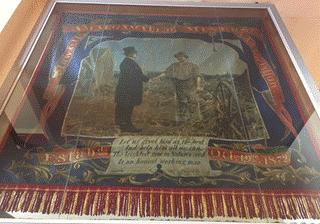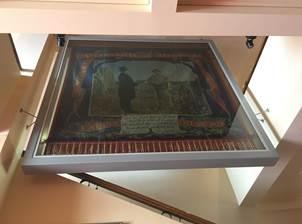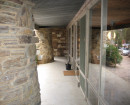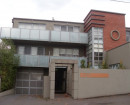STAWELL AMALGAMATED MINERS' ASSOCIATION BANNER
59-69 MAIN STREET STAWELL, NORTHERN GRAMPIANS SHIRE
-
Add to tour
You must log in to do that.
-
Share
-
Shortlist place
You must log in to do that.
- Download report



Statement of Significance
What is significant?
The Stawell AMA Banner.
How is it significant?
The Stawell AMA Banner is of historical significance to the State of Victoria. It satisfies the following criteria for inclusion in the Victorian Heritage Register:
Criterion A
Importance to the course, or pattern, of Victoria's cultural history.
Criterion B
Possession of uncommon, rare or endangered aspects of Victoria's cultural history.
Criterion D
Importance in demonstrating the principal characteristics of a class of cultural places and objects.
Why is it significant?
-
-
STAWELL AMALGAMATED MINERS' ASSOCIATION BANNER - History
The Stawell AMA Banner is a trade union banner which was displayed by the Stawell Branch of the AMA during sports day parades until 1909.
History of union banners
The tradition of parades where the banners of unions and friendly societies were displayed originated in Britain. The first parades and banners in Victoria focused on the Eight Hour Day Movement, but as unions were formed, banners were created as a means of identity for the various organisations. They were elaborately painted with imagery and wording, usually had tassels and fringing and were of a large scale to allow their prominent display on horse drawn carts. The imagery included tools and emblems associated with the various trades, and mottos espousing the beliefs and vision of the particular union or organisation. Figures depicted were usually men and if women were included, they were usually depicted as representations of ideals such as truth and wisdom.
Mining unions
The first mining unions in Victoria were established in the 1860s to protect the conditions and wages of miners on the goldfields when mining evolved from the use of labour intensive, simple surface-focused techniques undertaken by individual miners, to the establishment of large mining companies. Initially established in each mining area, the individual unions united in 1874 to form the AMA. Most branches had large banners which were displayed during parades as symbols of pride and solidarity and as a means of visual identification.
In March 1872, the Bendigo Miners' Association held the first annual Miners' Picnic and Sports Day, an event which was to define the miners' unions. It was held at Ravenswood and an estimated 3,000 people attended. In addition to sports such as quoits, foot racing, and hop, skip and jump, there was an open-air meeting where Robert Clark, President of the Bendigo Miners Association, stated that the picnic was also being held to celebrate the increasing success of the agitation for an eight hour day system. Three months after the Ravenswood Picnic and Sports Day, gold miners at Bendigo were awarded an eight hour working day, reputedly the first miners in the world to win the Eight Hour Day campaign. This was one of the most important industrial reforms won by unionists in the nineteenth century. Sports and picnic days became annual events, commencing with a procession in which the union banners were displayed. They were fund raising events, often declared public holidays by the mining companies and attended by huge crowds. For example, the Miners' Association Sports Day at Creswick in 1882 attracted 7,000 people with approximately 1,700 participants in the parade which was ¾ mile (1.2 kilometres) in length.
In June 1874, a conference of the individual miners' associations was held at Bendigo. The principal discussion focused on the formation of a union which would combine the multiple district unions and this resulted in the establishment of the AMA. As the Bendigo Advertiser reported, the philosophy of mutual satisfaction was to continue to guide the new association - 'there can be no question in the world that it will be better for both masters and men that a union of the sort to be formed, should exist. So long as one side is not unreasonable we are quite satisfied that the other will not be . the design of men, being selfish and corrupt, must be resisted and defeated'. These sentiments are expressed in the mottos on the Stawell AMA Banner.
While upholding reconciliation and industrial harmony, the AMA reserved the right to industrial action if its legitimate claims were denied. Through the AMA, miners had the strength to dispute wage reductions, defective equipment and poor working conditions. Miners went on strike to protect their rights and any miner who filled the place of a union member was disqualified from joining the AMA.
In October 1884, 39 delegates from the 20 branches of the AMA, including Stawell, held a conference in the Masonic Hall at Maldon. This meeting resulted in further amalgamation with other unions including the New South Wales Coalminers' Union to form Australia's first intercolonial union, the AMAA. Union rules were based on those of the National Miners' Association of Great Britain with a decentralised organisational structure with strong branches which were kept in close contact with the union's central committee through stewards appointed at each mine. In 1888, union membership in all Bendigo mines was made compulsory. These were progressive achievements which were later adopted by the emerging rural workers' unions. The AMAA presence spread from central Victorian goldmines, to all Victorian mining fields, and within a decade to Tasmania, Far North Queensland and New Zealand.
History of the Stawell banner
Stawell AMA held its first Sports Day in 1873 and a makeshift banner was displayed in the street parade which started in Patrick Street and ended at the Botanical Reserve (now the Old Lake Reserve) where the sporting activities occurred. This banner was replaced in the following year with a banner made by E P Bishop at a cost of £45. It was used in parades until 1903 when it fell into disrepair and was replaced by a replica banner made by W Rodgers at a cost of £22. This banner was used in the annual parade and sports day from 1904 until 1909 when the Stawell branch of the AMA decided not to hold their sports day owing to lack of support. The banner was held in storage until 1982 when it became the property of the Stawell Town Council. The banner underwent conservation and was subsequently unveiled at the Stawell Town Hall in 1990 where it is currently displayed.
The gold industry began to decline around World War I when gold production began to decrease in Bendigo, Victoria's most important mining centre. Stawell's largest goldfield, the Magdala-cum-Moonlight closed in 1917 and its mining plant was sold.
In 1918, the AMAA became part of the Australian Workers' Union. Unlike other unions, no substantial archival records of the AMA or the AMAA survive. The banner therefore provides the most tangible record of the union's aspirations and an insight into the character of nineteenth century miners.
KEY REFERENCES USED TO PREPARE ASSESSMENTBannear, D. (2004) 'A symbol of cooperation goes on display' Inherit Heritage Council Victoria, Issue 20, October 2004
Reeves, A. (2007) 'Trade Unionism and the Australian Mining Industry: the influence of Central Victorian goldminers, 1870 - 1920' in K. Reeves & D. Nichols (eds.) Deeper Leads: new approaches to Victorian goldfields history, BHS Publishing, Ballarat, Victoria, 2007
Smith, B. Australian Trades Union Archives Retrieved from URL: http://www.atua.org.au 17/01/2012.
Conservation works completed by Victorian Centre for the Conservation of Cultural Material (c.1990)
STAWELL AMALGAMATED MINERS' ASSOCIATION BANNER - Assessment Against Criteria
Criterion
The Stawell AMA Banner is of historical significance to the State of Victoria. It satisfies the following criterion for inclusion in the Victorian Heritage Register:
Criterion A
Importance to the course, or pattern, of Victoria's cultural history.
Criterion B
Possession of uncommon, rare or endangered aspects of Victoria's cultural history.
Criterion D
Importance in demonstrating the principal characteristics of a class of cultural places and objects.
STAWELL AMALGAMATED MINERS' ASSOCIATION BANNER - Permit Exemptions
General Exemptions:General exemptions apply to all places and objects included in the Victorian Heritage Register (VHR). General exemptions have been designed to allow everyday activities, maintenance and changes to your property, which don’t harm its cultural heritage significance, to proceed without the need to obtain approvals under the Heritage Act 2017.Places of worship: In some circumstances, you can alter a place of worship to accommodate religious practices without a permit, but you must notify the Executive Director of Heritage Victoria before you start the works or activities at least 20 business days before the works or activities are to commence.Subdivision/consolidation: Permit exemptions exist for some subdivisions and consolidations. If the subdivision or consolidation is in accordance with a planning permit granted under Part 4 of the Planning and Environment Act 1987 and the application for the planning permit was referred to the Executive Director of Heritage Victoria as a determining referral authority, a permit is not required.Specific exemptions may also apply to your registered place or object. If applicable, these are listed below. Specific exemptions are tailored to the conservation and management needs of an individual registered place or object and set out works and activities that are exempt from the requirements of a permit. Specific exemptions prevail if they conflict with general exemptions. Find out more about heritage permit exemptions here.Specific Exemptions:It should be noted that Permit Exemptions can be granted at the time of registration (under s.49(3) of the Heritage Act 2017). Permit Exemptions can also be applied for and granted after registration (under s.92 of the Heritage Act 2017).
General Condition 1
All exempted alterations are to be planned and carried out in a manner which prevents damage to the fabric of the registered place or object.
General Condition 2
Should it become apparent during further inspection or the carrying out of works that original or previously hidden or inaccessible details of the place or object are revealed which relate to the significance of the place or object, then the exemption covering such works shall cease and Heritage Victoria shall be notified as soon as possible.
General Condition 3
All works should ideally be informed by the Collection Policy prepared for the object. The Executive Director is not bound by any Collection Policy, and permits still must be obtained for works suggested in any Collection Policy.
General Condition 4
Nothing in this determination prevents the Heritage Council from amending or rescinding all or any of the permit exemptions.
Conservation
Written notification is required for any proposed conservation activities. The applicant will then be notified by the Executive Director whether the conservation activity requires permit approval pursuant to the Heritage Act 2017, or whether it is permit exempt.
STAWELL AMALGAMATED MINERS' ASSOCIATION BANNER - Permit Exemption Policy
Preamble
The purpose of the Permit Policy is to assist when considering or making decisions regarding works to a registered place or object. It is recommended that any proposed works be discussed with an officer of Heritage Victoria prior to making a permit application. Discussing proposed works will assist in answering questions the owner may have and aid any decisions regarding works to the object or to the place in which it is located.
The extent of registration of the Stawell AMA Banner in the Victorian Heritage Register consists of the banner itself. Under the Heritage Act 2017 a person must not remove or demolish, damage or despoil, develop or alter or excavate, relocate or disturb the position of any part of a registered place or object without approval. It is acknowledged, however, that conservation may be required to keep places and objects in good repair and adapt them for use into the future.
If a person wishes to undertake works or activities in relation to a registered place or registered object, they must apply to the Executive Director, Heritage Victoria for a permit. The purpose of a permit is to enable appropriate change to a place and to effectively manage adverse impacts on the cultural heritage significance of a place as a consequence of change. If an owner is uncertain whether a heritage permit is required, it is recommended that Heritage Victoria be contacted.
Permits are required for anything which alters the place or object, unless a permit exemption is granted. Permit exemptions usually cover routine maintenance and upkeep issues faced by owners as well as minor works or works to the elements of the place or object that are not significant. They may include appropriate works that are specified in a conservation management plan. Permit exemptions can be granted at the time of registration (under s.49(3) of the Heritage Act 2017) or after registration (under s.92 of the Heritage Act 2017).
Collection Management
It is recommended that the Stawell AMA Banner is included in any Collection Policy (CP) developed to manage the collection held by the Northern Grampians Shire Council in a manner which preserves its cultural heritage significance. If a CP does not exist, it is recommended that a policy be developed for management of the banner. The CP documentation and all aspects of the management of the banner should be in accordance with the National Standards for Australian Museums and Galleries.
It is also recommended that a formal arrangement is made to ensure the survival of the Stawell AMA Banner in the event that it can no longer be exhibited in the Stawell Town Hall. This arrangement should provide for the preservation of the banner and ensure that it remains publicly accessible.
Security
Fire detection and suppression systems suitable for museum use should be installed if this has not already occurred. A Disaster Plan should be prepared and implemented in accordance with Museums Australia's standards. A security system suitable for museum use should be installed.
Movement or Relocation
Temporary external movement, permanent relocation, or loan of objects requires permit approval by the Executive Director pursuant to the Heritage Act 2017.
The temporary relocation or movement of a registered heritage object resulting from works to the building in which the object is housed requires permit approval by the Executive Director pursuant to the Heritage Act 2017. Works to the building where the Stawell AMA Banner is held have the potential to damage the Banner. These works include but are not limited to the works listed below. The Banner must be removed if the works are likely to impact the area in which the Banner is located before the works commence and not be returned until after the works have been completed. If works occur in another area of the building, the Banner should be protected from potentially damage causing elements, including dust.
. Renovation of the building.
. Demolition, removal or installation of walls, ceilings, wall linings, doors, windows, bathroom, kitchen or office fitouts, lights, built-in furniture, and the like.
. Installation, removal or replacement of electrical wiring, computer and audio visual systems.
. Repairs and maintenance.
. Painting of walls and ceilings.
. Vermin control.
. Security and fire detection and suppression.
-
-
-
-
-
HILL PIPE ORGAN - ST PETER'S LUTHERAN CHURCH
 Victorian Heritage Register H2177
Victorian Heritage Register H2177 -
CENTRAL PARK
 Victorian Heritage Register H2284
Victorian Heritage Register H2284 -
COMMONWEALTH MEMORIAL
 Victorian Heritage Register H1943
Victorian Heritage Register H1943
-
'Mororo' 13 Oxford Street, Malvern
 Stonnington City
Stonnington City -
1 Arnold Street
 Yarra City
Yarra City -
1 Austin Street
 Yarra City
Yarra City
-
-












